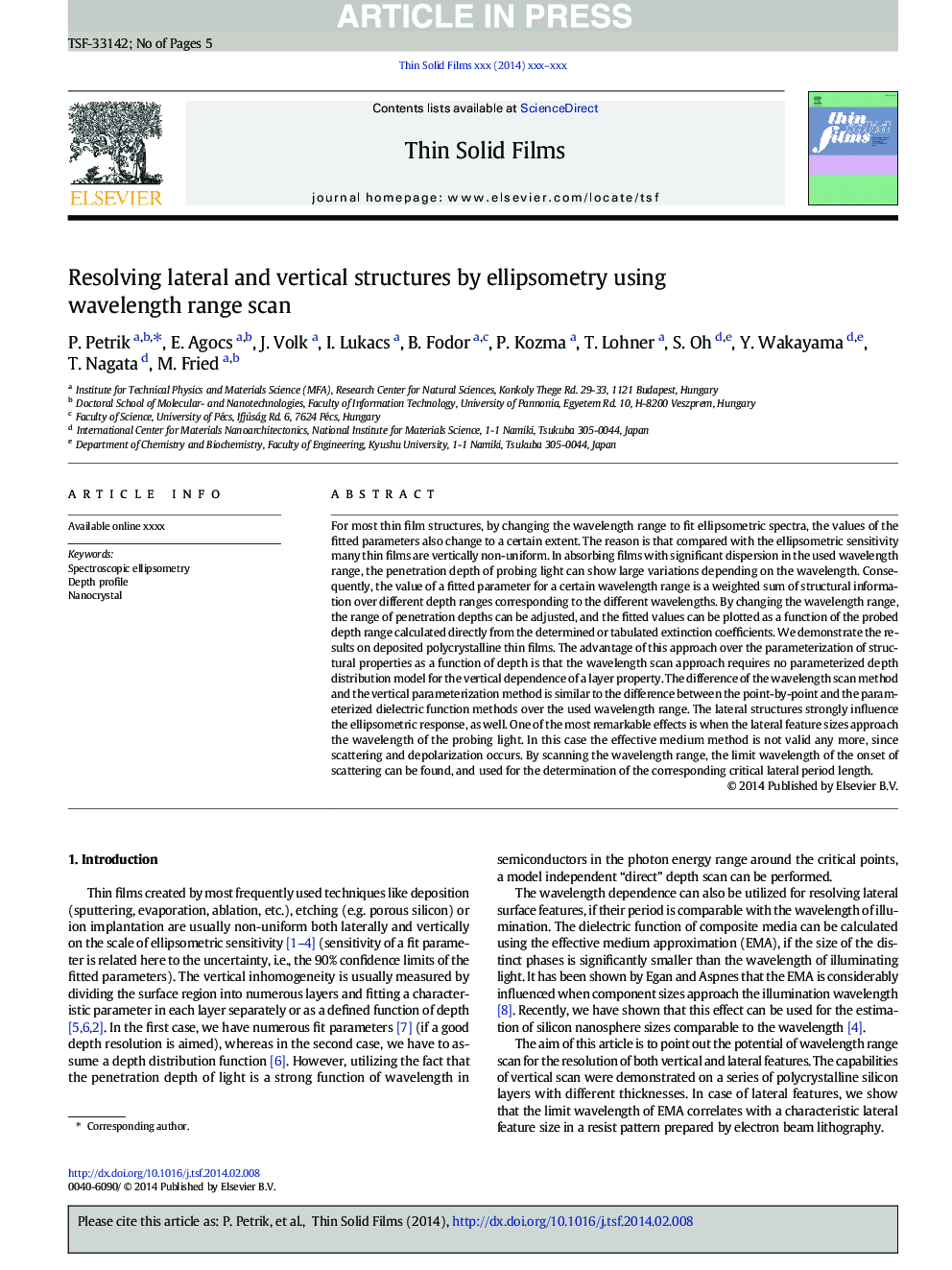| کد مقاله | کد نشریه | سال انتشار | مقاله انگلیسی | نسخه تمام متن |
|---|---|---|---|---|
| 10669690 | 1008781 | 2014 | 5 صفحه PDF | دانلود رایگان |
عنوان انگلیسی مقاله ISI
Resolving lateral and vertical structures by ellipsometry using wavelength range scan
ترجمه فارسی عنوان
حل ساختارهای جانبی و عمودی با استفاده از بیسپسیمتری با استفاده از اسکن دامنه طول موج
دانلود مقاله + سفارش ترجمه
دانلود مقاله ISI انگلیسی
رایگان برای ایرانیان
کلمات کلیدی
بیضه سنجی طیف سنجی، مشخصات عمق، نانوکریستال،
ترجمه چکیده
برای بیشتر سازه های نازک فیلم، با تغییر طول طیف موج به تناسب طیف های بیضوی، مقادیر پارامترهای نصب شده به میزان مشخص تغییر می کنند. دلیل آن این است که در مقایسه با حساسیت بیضی سنجی، بسیاری از فیلمهای نازک به طور عمودی یکنواخت نیستند. در جذب فیلم ها با پراکندگی قابل توجهی در محدوده طول موج مورد استفاده، عمق نفوذ نور پروب می تواند تغییرات بزرگی را با توجه به طول موج نشان دهد. در نتیجه، ارزش یک پارامتر نصب شده برای محدوده خاصی از طول موج، یک مجموع وزنی اطلاعات ساختاری در محدوده عمق مختلف مربوط به طول موج های مختلف است. با تغییر طول طیف موج، محدوده عمق نفوذ را می توان تنظیم کرد، و مقادیر نصب شده را می توان به عنوان یک تابع از محدوده عمق پروب که به طور مستقیم از ضرایب انقباض تعیین شده یا جدول محاسبه شده است، ترسیم می شود. نتایج ما را در فیلم های نازک پلی کریستالی پوشیده شده نشان می دهد. مزیت این روش برای پارامتر کردن خواص ساختاری به عنوان تابع عمق این است که رویکرد اسکن طول موج نیازی به مدل توزیع عمق پارامتری برای وابستگی عمودی یک ویژگی لایه ندارد. تفاوت روش اسکن طول موج و روش پارامتر عمودی شبیه به تفاوت بین نقطه به نقطه و روش های تابع پارامتر دی الکتریک در طول محدوده طول موج مورد استفاده است. ساختارهای جانبی نیز به شدت روی پاسخ بیضه سنجی تأثیر می گذارند. یکی از تاثیرات قابل توجه این است که اندازه ویژگی های جانبی به طول موج نور پروب نزدیک می شود. در این حالت، روش متوسط موثر، معتبرتر از آن نیست که پراکندگی و قطب دهی رخ دهد. با اسکن کردن محدوده طول موج، طول موج محدودی از شروع پراکندگی را می توان یافت و برای تعیین مدت طول دوره جانبی جانبی مورد استفاده قرار می گیرد.
موضوعات مرتبط
مهندسی و علوم پایه
مهندسی مواد
فناوری نانو (نانو تکنولوژی)
چکیده انگلیسی
For most thin film structures, by changing the wavelength range to fit ellipsometric spectra, the values of the fitted parameters also change to a certain extent. The reason is that compared with the ellipsometric sensitivity many thin films are vertically non-uniform. In absorbing films with significant dispersion in the used wavelength range, the penetration depth of probing light can show large variations depending on the wavelength. Consequently, the value of a fitted parameter for a certain wavelength range is a weighted sum of structural information over different depth ranges corresponding to the different wavelengths. By changing the wavelength range, the range of penetration depths can be adjusted, and the fitted values can be plotted as a function of the probed depth range calculated directly from the determined or tabulated extinction coefficients. We demonstrate the results on deposited polycrystalline thin films. The advantage of this approach over the parameterization of structural properties as a function of depth is that the wavelength scan approach requires no parameterized depth distribution model for the vertical dependence of a layer property. The difference of the wavelength scan method and the vertical parameterization method is similar to the difference between the point-by-point and the parameterized dielectric function methods over the used wavelength range. The lateral structures strongly influence the ellipsometric response, as well. One of the most remarkable effects is when the lateral feature sizes approach the wavelength of the probing light. In this case the effective medium method is not valid any more, since scattering and depolarization occurs. By scanning the wavelength range, the limit wavelength of the onset of scattering can be found, and used for the determination of the corresponding critical lateral period length.
ناشر
Database: Elsevier - ScienceDirect (ساینس دایرکت)
Journal: Thin Solid Films - Volume 571, Part 3, 28 November 2014, Pages 579-583
Journal: Thin Solid Films - Volume 571, Part 3, 28 November 2014, Pages 579-583
نویسندگان
P. Petrik, E. Agocs, J. Volk, I. Lukacs, B. Fodor, P. Kozma, T. Lohner, S. Oh, Y. Wakayama, T. Nagata, M. Fried,
